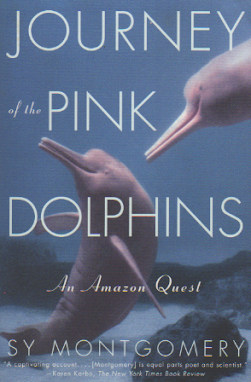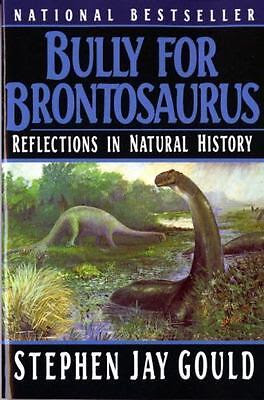First Impressions Review: Journey of the Pink Dolphins, by Sy Montgomery
I was excited to pick this book up because as a kid I’d learned about the pink river dolphins of the Amazon and the legends of them being seductive shapeshifters and was interested to find out more. And I did…sort of. Botos are, it turns out, quite hard to study because the waters where they live are often murky and they don’t tend to leap spectacularly out of it like other dolphins do. There is a lot that even scientists who have spent their whole lives studying them don’t know. So much of this book is the author’s own fish-out-of-water story of traveling around the Amazon basin trying to see dolphins – and eventually succeeding – and, in the meantime, having various tropical travel mishaps and learning about other animals and about the mythology surrounding botos. The writing style is beautiful, evocative, and sensual…which suits the primary subject of the book, but does get a little misapplied in places.
Besides the dolphins, we get to meet electric eels, armored catfish, river tortoises, manatees, various monkeys, and many other fascinating critters.
“At night, even the stars seem brighter in the water than in the sky. The constellations shine above, their starry reflections below, and from the trees, the glowing eyes of wolf spiders, tree boas, tree frogs. In your canoe, you feel like you are travelling through the timeless starscape of space.”
The world the botos inhabit is one that would seem rather strange to outsiders – one where forests flood for half the year, leading fish to disperse seeds and sloths to swim, and ancient lineages of creatures dating back to before the Andes mountains still persist. The reason the botos are so unusually flexible for dolphins and have such reduced dorsal fins is so they can swim between underwater branches. It is little wonder that local people imagined them inhabiting enchanted underwater cities.
The story goes that botos – who love parties - can transform themselves into irresistibly beautiful men or women, but one must beware of this temptation. The author never brought this up, but I found it odd and intriguing that the transformed botos are specifically described as being pale skinned and blonde-haired – a phenotype you don’t see much in the Amazon! - and offering riches including fancy watches or jewelry to their paramours. I can’t help but think that this indigenous legend has been updated sometime in the last few centuries to warn against a particular type of seductive stranger who might leave you pregnant or take you away from your home forever! It is also important not to anger a boto, as they can shoot invisible pain-causing darts or otherwise cause mischief to those who offend them. This is fortunate for the dolphins, as otherwise people might be more tempted to hunt them for their eyes, fat, or genitalia, which are said to have magical properties, mostly associated with love potions. As I mentioned above, I think the beautifully sensual writing style fits the subject pretty well. For example:
“One of the dolphins, a dark gray one, surfaced so close to our boat I could have touched her. She opened the top of her head to us. I stared down her blowhole, an intimate, mysterious abyss of life, and inhaled her moist breath.”
However, the way it got applied to people sometimes rubbed me the wrong way.
First, we have Montgomery admitting she basically thinks everyone in Manaus dresses like a streetwalker. Then we have this lovely yet weirdly unprofessional description of her primary scientific contact as: “smooth and supple as a sea creature…in the curve of her lips when she smiles, and when her dark eyes dance with humor. Her laughter reminded me of bubbles…” Between that and the comparison of passionfruit to semen, I was thinking: “Dang, girl! Do you need to jump in the river and cool off1?” She seemed to calm down after that, but the oddly poetic physical descriptions of Brazilian guides and scientists continued, one having a voice “soft as wet leaf litter” and “dark dreamy eyes”, another having “the muscled physique of an athlete…beautiful light brown eyes and glossy black hair…she was the sort of woman men literally fought over.” I would have chalked this up to Montgomery just being overwhelmed by the tropical fecundity or something, but then she and her photographer stay with a whole houseful of white dudes, most of whom get no physical description at all. I noticed that other American or European people didn’t tend to get described so…lushly either. Charitably, I suspect the intent may have been to point out “Look, not all scientists are weedy-looking white guys in lab coats.” But, speaking as one of those who might not look like people’s expectation of a scientist - I would be pretty uncomfortable if I had a normal conversation with a journalist about climate change and trees, and picked up their book to discover that I’d been described like some kind of forest nymph! I mean, obviously the guy who wrestles crocodilians as part of his job has muscles…but there’s no need to go on about it at length, because it starts to feel exotifying.
1. To which one of my friends replied: “No, don’t let the very horny woman in the river with the horny dolphins. It’s a recipe for disaster!” (Dolphins do deserve their reputation, by the way – they rank with humans and bonobos for creativity in that arena of life!)
In general, I kept going back and forth about whether I liked the approach to the local culture. One thing hampering a deeper look is that the author does not speak Portuguese, so she couldn’t talk to any of the less educated people she met directly. If she could have, it might have cleared up some misconceptions. For instance, at one point she assumes that the locals have so many children despite the fact that an “abortion vine” grows in the forest for religious reasons. No, Sy, it’s because using herbal abortifacients works on the same principle as chemotherapy – you hope it poisons what you’re trying to get rid of before it poisons you! It’s super dangerous. Most Brazilians started using modern birth control measures, including sterilization, enthusiastically as soon as they became available in their area. The average children per woman dropped rapidly in Brazil from 1961 on (from ~6), reaching 2.3 by 2000, the year this book was published, and 1.66 by 2020. On the other hand, she did rightly guess that not going to visit the family of a child they briefly met who had died would be rude. She marveled at the focus on warmth and togetherness over awkward condolences and solitary grief2…but such an approach isn’t foreign to all northern cultures, as that is the same basic philosophy behind an Irish wake! Overall, though, I couldn’t help but be charmed at how she put herself out there even when it would make her look silly. I found the description of her ayahuasca vision quest really funny. She first gets jealous of the photographer for having more dolphin dreams, then gets so nauseous she wants to die, and eventually hallucinates the Starship Enterprise. The shaman - once they manage to vaguely explain what that is - doesn’t even blink, simply explaining that the spirits would normally send a canoe to represent a journey, but since the author is from a technologically advanced country, they must have thought that would make more sense!
2. This kind of “party celebrating life” is also what my grandmother requested and got… but she was 96, so possibly those of us who grew up in the US had an easier time going along with that than we would have for a drowned 3 year old!
I appreciated too the way Montgomery highlights both the exploitation and genocide of indigenous people and the various threats facing the forest and the dolphins - fires and dams in particular. It hurts my heart to know that, 20 years later and especially under the current Brazilian president, all those threats have gotten worse. I wonder how the children of those dolphins she danced with and the people she met are doing. One positive is that the kinds of conservation efforts that empower local residents in managing reserves, which were new when this book was written, have been shown across the tropics to have at least similar success to traditional protected areas in reducing deforestation, especially when they involve supporting indigenous land tenure.
Overall recommendation: Beautifully written, entertaining, and informative…only the unfortunate hints of unexamined colonial thinking keep this from being a 5-star work of nature writing.



